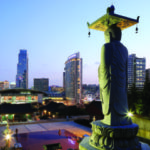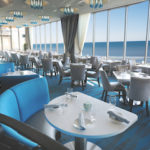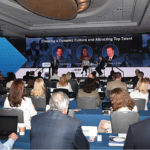It started small, with a simple inquiry to see if NBTC Holland Marketing would be interested in hosting Convene at the World Justice Forum conference in The Hague this past July. NBTC agreed enthusiastically, and also suggested we visit some of the country’s other meeting destinations while we were there. The end result was a barnstorming tour of the lovely northern European country, covering four cities in five summer days — Amsterdam, The Hague, Maastricht, and Rotterdam — including time at the World Justice Forum, which we’ll be profiling in our November issue.
Seeing four destinations one right after the other helped me get beyond what to an international traveler can seem like the monolithic culture of a foreign country and appreciate each city’s differences, highlighting its strengths and idiosyncrasies. It was an ambitious and at times exhausting itinerary, and a lot of fun. Here’s some of what I experienced.
AMSTERDAM: BRIGHT LIGHTS, BIG CITY
 |
I landed at Amsterdam Airport Schiphol on a brilliant Monday morning — a jewel of a day that locals welcomed after a long winter and a rainy spring — and was driven to my host hotel, the Hotel Okura Amsterdam. From the car I got quick, enticing glimpses of Amsterdam’s capital — the concentric half-circles of canals ringing the city center, the skyline mashup of classic and modern architecture, and, everywhere, people on bicycles.
I freshened up at the Okura. Located along Amstel Canal, a short walk from the Amsterdam RAI convention center, it’s a gorgeously modern property, sleek and angular, with 300 guest rooms and 27,000 square feet of meeting space. Then it was a quick cab ride to Café-Restaurant Dauphine, where I met my hosts from Amsterdam Marketing. And, after a coffee on Dauphine’s spacious streetside patio, we were off for a daylong tour, conducted almost entirely on foot, through Amsterdam’s compact, lively urban core.
Our first stop was the Hotel Casa 400 Amsterdam, a squat, sturdy cube of floor-to-ceiling windows that sits a three-minute walk from Amsterdam Amstel railway station. Casa 400’s 520 guest rooms and 13 meeting and conference rooms are all splashed with light, due in part to the serene open-air garden that sits in an atrium-like space at the center of the property.
At EYE Film Institute Netherlands, a striking white building that juts over the IJ river on the north side of Amsterdam’s waterfront, we wandered through a dazzling array of spaces, from museum exhibits to theaters to meeting rooms, to the soaring EYE bar-restaurant and its riverside terrace.
From there we hopped a ferry back across the IJ — a free, 24-hour service from Amsterdam’s GVB public-transportation company — and made our way to the Beurs van Berlage, just a few minutes from Amsterdam Central train station. Built as a commodities exchange at the turn of the century, the Beurs’ red-brick construction, stone columns, and iron-and-glass roof recall the industrial age even as the facility offers 55,000 square feet of thoroughly modern event space, including the 17,000-square foot Great Hall.
Several blocks away, the 402-room Renaissance Amsterdam Hotel offers more than 15,000 square feet of event space — including, just across the street, the 17th-century Koepelkerk, a former Lutheran church whose beautiful copper dome is an area landmark.
Just a few blocks farther, three 17th-century canal houses that once hid a clandestine church today operate as De Rode Hoed (“the redhead”), a charming red-brick venue with a foyer and bar, sitting rooms, boardrooms, and a lecture hall. Buried at the center of De Rode Hoed is the main hall of the old wooden church, a three-story in-the-round space that can accommodate up to 450 people for seated gatherings.
My first day in Holland wrapped up on a timeless note, at Sofitel Legend The Grand Amsterdam, an opulent property that first housed two 16th-century convents, then the Admiralty of Amsterdam, which added a new building with a stunning façade, and finally, for nearly 200 years, Amsterdam’s city hall. Today, the 178-room Sofitel Grand is a classic beauty that sprawls around a cobblestoned courtyard, with nine “historical” meeting rooms — including the 3,175-square-foot Council Chamber, built in 1924 for Amsterdam’s city council — and, spread over three floors, the nearly 10,000-square-foot Princehof Meeting & Convention Centre.
The next morning was another stunner, clear and bright and mild. Perfect weather for a day at the beach, which is where I unexpectedly found myself after a tour of Amsterdam RAI, Holland’s largest conference and exhibition center. Not only does the sprawling RAI complex offer more than 1 million square feet of space, including 11 exhibit halls, from 11,000 to 161,000 square feet, and the Elecium conference center, with a 20,000-square-foot ballroom and 20 meeting rooms — the facility also sits adjacent to Strand Zuid, a beach property with sand, lounge chairs, hammocks, and a cool, relaxed restaurant, where I enjoyed a cold drink at the water’s edge before taking my leave of Amsterdam.
The RAI had that covered, too. The complex is home to its own rail station (along with subway, bus, and canal stops), making it a snap to catch the train to my next destination, a little more than 30 miles to the southwest: The Hague.
THE HAGUE: SEAT OF POWER
 |
If Amsterdam is Holland’s New York City — bright and urbane, with seemingly limitless energy — The Hague is its Washington, D.C., leafy and elegant, even stately. As my hosts with Den Haag Marketing noted, the destination is known as the City of Peace and Justice, and for good reason. Situated on the North Sea, The Hague is the seat of the Dutch government and supreme court, and home to more than 150 international organizations, including the International Court of Justice, the International Criminal Court, and the International Criminal Tribunal for the former Yugoslavia (ICTY).
Many of those organizations are based in the city’s international zone, a short ride from downtown, and so is much of its meetings infrastructure, including Worldhotel Bel Air The Hague. With 300 guest rooms, a 3,000-square-foot congress hall, and 20 meeting rooms, the Bel Air is one of The Hague’s premier conference properties — located just next door to the World Forum convention center, which was hosting the World Justice Forum.
After spending a few hours at the World Justice Forum, I checked into my host hotel, the Crowne Plaza Den Haag – Promenade, which also sits adjacent to the World Forum. It’s another impeccable property for international business, with 174 guest rooms and eight conference and boardrooms.
I had a free evening, so I walked from the Crowne Plaza through the lush Scheveningen Woods, along one of The Hague’s many wide, tree-lined boulevards, and into the city center. It was a beautiful night in a beautiful city. A steady breeze blew off the North Sea, and standing at the edge of the Hofvijver pond, looking over the shimmering water at the 600-year-old clutch of buildings that house the Dutch parliament and at the jagged line of modern skyscrapers rising up behind them, it wasn’t hard to trace a line through the centuries to today’s City of Peace and Justice.
The next morning, I walked from the Crowne Plaza back to the World Forum to learn more about the 160,000-square-foot venue, which shares a neighborhood with the ICTY, the Organisation for the Prohibition of Chemical Weapons, and, directly across the street, the residence of the Dutch prime minister. With nearly 110,000 square feet of exhibit space, 27 meeting rooms, and a 2,161-person auditorium, the World Forum can host events for up to 5,000 people. And, over the next three years, The Hague is investing 25 million euros to expand the facility’s exhibition space and upgrade its technological infrastructure.
Then a guide from Den Haag Marketing collected me for a fast-moving tour of the old city. After two flawless summer days, the sky had reverted to Holland’s usual iron-gray ceiling, but the weather was still mild as we hopped a tram that took us into the heart of town. Our first stop: the Hotel Des Indes, a 92-room property with 4,200 square feet of meeting space that was built as a palace in 1858. Gorgeously, almost sinfully appointed, the lemon-yellow grand dame sits on Lange Voorhout square, a famous part of The Hague’s diplomatic community that’s home to numerous embassies, including those of the United States and Great Britain.
In just a few short blocks, we moved from the city’s past into its glimmering present, visiting the cutting-edge contemporary Hilton The Hague. Sharp and professional, the 195-room Hilton offers four boardrooms, five meeting rooms, and a 3,520-square-foot ballroom.
That would be my last impression of The Hague, and it was perfect: a flawlessly modern venue perched amid history itself, a new idea standing on the shoulders of an old world. Little did I know on my train ride that afternoon, two-and-a-half hours southeast, to the very bottom of Holland, that when it came to the old world, I had barely scratched the surface.
MAASTRICHT: ON THE BORDER
 |
Straddling the Meuse (known in Dutch as the Maas) river, up against the border with Belgium, an easy stone’s throw from Germany, Maastricht is a medieval city whose ease and warmth belie a formidable network for business meetings. Both of those aspects revealed themselves quickly during my first day in the destination.
The Maastricht Convention Bureau picked me up at the train station and took me right to the Maastricht Exhibition & Congress Centre (MECC Maastricht). The sleek facility has more than 320,000 square feet of exhibition space, 30 breakout rooms, and two auditoriums that combined can seat 1,650 people. Just as impressive, MECC Maastricht is directly next to the Maastricht Health Campus, an ambitious complex of clinics, research labs, and education institutions that offer a wealth of resources for medical conferences.
From there we left town, driving through the intensely green Jeker valley and up to Château Neercanne, a 17th-century castle in the hills overlooking Belgium that today offers a variety of unique event spaces, including Baroque gardens, terraces, conference and banquet rooms, a restaurant, and, burrowed into the cliffs behind the château, a series of cool, atmospheric wine cellars.
Château Neercanne is one of a handful of properties owned by Camille Oostwegel — all of them “housed in monumental buildings with a rich cultural history,” according to Oostwegel’s website. They include my host hotel, Kruisherenhotel Maastricht, which occupies a church that was built in 1520 and about 10 years ago was carefully reimagined as a magnificent 60-room property that preserves the building’s original lines and structures — and even offers three conference rooms that each can accommodate from four to 20 people. That night I enjoyed a leisurely dinner with Marcel Knols, the convention bureau’s managing director, in Kruisherenhotel’s restaurant, floating on a mezzanine level among the stained glass and gothic arches of the old church.
The next morning, a guide from the bureau took me on a stroll through the city center. It was gray and chilly, and as we navigated the narrow, winding streets, through small public squares, past crumbling segments of the old city wall, and over the Meuse, it would have been easy to slip into the past — except for the high-end shops, boutiques, and bars that line Maastricht. We stopped for a coffee at Selexyz Dominicanen, a 13th-century Dominican church that’s been converted into a bookstore and café, then later popped in to the Museum aan het Vrijthof, housed in the 16th-century Spanish Government building, and full of light thanks to a transparent roof soaring over its courtyard. Eventually we ended up at Maastricht University, internationally respected, with nearly 16,000 students, and, like the health campus, offering valuable resources for meeting planners. The university was only founded in 1976, but seems much older because it occupies a series of 16th- and 17th-century buildings in the city center.
Perhaps the best indicator of Maastricht’s old-world charm and the comfort it engenders in visitors is that, after our walk, I was eager to say goodbye to my guide — an engaging, knowledgeable companion — and spend some time on my own. By the time I’d made my way to the train station, after a quiet lunch at a window seat at Harry’s in the Hotel Beaumont, I felt like I’d been welcomed as a friend. The final leg of my trip beckoned – heading back north, to Rotterdam — but I wasn’t sure I was ready to leave.
ROTTERDAM: WINNING THE WAR
 |
But Rotterdam cured me of that. Rotterdam Central station, where I got off the train, is in the middle of a huge improvement project that’s creating a transportation hub in the heart of the city. The space is light and airy, with an angular, shiny silver roof that points like an arrow toward the center of Rotterdam. And that’s where my host from Rotterdam Marketing and I headed, following the arrow’s path across the street and into The Manhattan Hotel for a coffee.
The 230-room Manhattan is a striking property, tall and elegant, with more than 7,000 square feet of function space. It’s connected via covered skyb ridge to De Doelen International Conference Centre, a meeting space and concert venue that offers three interconnected complexes of breakout rooms, foyers, and exhibit space, each one anchored by a performance-quality auditorium — 1,755-seat Large Hall, 700-seat Willem Burger Hall, and 465-seat Juriaanse Hall.
From De Doelen, we walked several blocks to Beurs-World Trade Center, a business complex that includes shops, offices, and the 37-room Congress & Event Center, with features such as 10,800-square-foot Rotterdam Hall, 11,400-square-foot Exchange Hall, and, on the 23rd floor of the building, a breathtaking event space offering panoramic views of Rotterdam.
Standing outside on a glass-walled balcony, staring across the skyline, revealed something jarring: Rotterdam, the second-largest city in Holland, home to the busiest port in Europe, looks much newer than it actually is. That’s because the city, founded on the Rotte river in 1270, was literally flattened by Germany during the Rotterdam Blitz in World War II, with only a few buildings surviving. After the war, city officials were determined to rebuild quickly and boldly, and today Rotterdam is known for its architectural marvels – high-rises and bridges that soar and surge against the sky. That spirit has come to define the city’s character. As more than one local told me: “We roll up our sleeves and get to work.”
Another brisk walk and we were at our final stop for the day: the Grote of Sint-Laurenskerk, a 15th-century church and the oldest building in Rotterdam. One of the few survivors of the blitz, Sint-Laurenskerk is still used for church services, but also serves as a venue for events from 25 to 1,000 people, from conferences and receptions to seated dinners.
After a relaxing dinner with Rotterdam Marketing, I checked into my host hotel, the Mainport, a chic waterfront property that gleams behind a glass and aluminum façade. The next morning we toured the 215-room Mainport, which has nine meeting rooms spread over 2,000 square feet, many of them offering views of the harbor and the Meuse river, which, like Maastricht, Rotterdam straddles.
Those views are certainly enticing, so I was happy that we rode a fast-moving water taxi to our next destination, the driver gunning along the Meuse before steering us on a gradual arc that took us to the SS Rotterdam. Launched in 1958, the 750-foot, 39,000-ton ocean liner is now a permanently moored, 254-room hotel and conference venue that can accommodate groups of up to 3,500 people with 16,000 square feet of event space, including breakout rooms, board rooms, “Mad Men”–era bars and lounges, a 500-person theater, and the 1,400-square-foot Grand Ballroom.
Our next mode of transport was a tuk-tuk — a sort of three-wheeled, motorized rickshaw popular in some Dutch cities — which zipped us over to the Wilhelmina Pier, a former dock from which many ships left for the United States during the late-19th and early-20th centuries. Today the pier is home to some of Rotterdam’s tallest, most modern buildings, helping give the city its local nickname “Manhattan on the Maas.”
Six venues on the pier have banded together to market themselves as Congress Island. We met with representatives of the initiative at one of the venues — Hotel New York, which occupies the former headquarters of the Holland America Line, the passenger line that transported hundreds of thousands of people to the United States from all over Europe. The 72-room property has seven high-ceilinged meeting rooms, and is steeped in the history of Holland America, with large turn-of-the-century photos of blank-faced emigrants, original boardroom furnishings, and other period décor. The other venues making up Congress Island are the 1,535-seat Luxor Theatre; the solar-powered Floating Pavilion, consisting of three experimental “hemispheres” that are designed as examples of sustainable, “climate-change-proof” architecture; the historic Cruise Terminal Rotterdam, with a variety of function spaces; LP2, in the Las Palmas “cultural warehouse,” with a 4,100-square-foot exhibit hall and a 150-person auditorium; and LantarenVenster, a cinema house with five screening rooms and a multifunction hall.
My final trip in Rotterdam was also via tuk-tuk, to Witt de Withstraat, a lovely street lined with cafés, art galleries, restaurants – and Hopper, a bright, casual coffee shop where my Rotterdam Marketing escort and I enjoyed fresh sandwiches and good, strong coffee. Then it was back to Rotterdam Central for an express train to Amsterdam Airport Schiphol, and my flight home, during which I realized, belatedly and somewhat sheepishly, that I hadn’t learned a word of Dutch during my entire trip. Everyone I met — not just the hospitality and travel professionals who hosted me, but everyone — spoke perfect English. It’s one of the many things that make Holland friendly and welcoming, and primed for international business.



